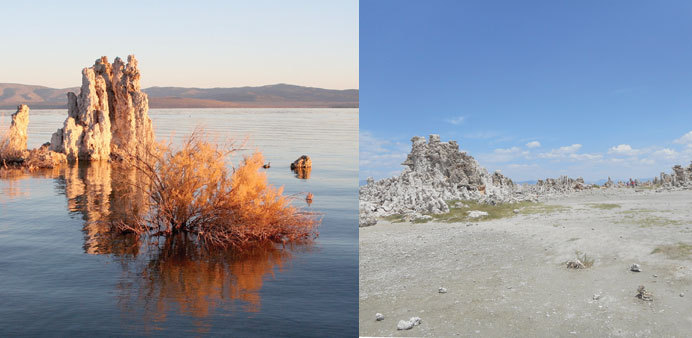BEFORE: Mono Lake in California in 2006. Photo by Brocken Inaglory Right: AFTER: Mono Lake in California in August 2014. Photo by Maryphillips1952
By Steff Gaulter
It no longer looks like a dam. Instead the 75-acre dam in Sylmar, California looks more like a child’s ball pit, except much less colourful. That’s because officials have floated 96 million black balls on top of the Los Angeles Reservoir in a desperate attempt to beat the drought.
The idea is that the black balls will block sunlight and help prevent evaporation. Water loss due to evaporation is a serious problem faced by dams in many parts of the world. In fact, in some parts of Australia, it’s estimated that evaporative losses from some farm dams is greater than the amount of water that is actually used for irrigation.
Wherever you are in the world, for every ten centimetres of water lost by evaporation from a one hectare dam surface, one million litres of water is lost. Another problem with evaporation is that when the water evaporates, any impurities are left behind. As the concentration of impurities increases, the water becomes less potable. California is desperately trying to preserve every drop of water because the state is now in its fourth year of drought and it is showing no signs of breaking any time soon.
Most of the year’s rain that southern California receives usually falls in the winter. A thin ribbon of strong winds high up in the atmosphere, known as the jet stream, regularly guides storms towards the west coast of the USA in the cooler months. These winds are known as the Pineapple Express, because they deliver the rain directly from Hawaii. San Francisco, for example, usually receives 85 percent of its rain in the five months between November and March. If this rain fails, then the state often has water problems for the entire year. Over the past few years, the winter jet stream has shifted northwards and the vital winter rains have failed to materialise. This has left the state in the grip of its worst drought for over 1,000 years.
California has a history of water problems; the rain is far heavier in the north of the state, but the majority of the population live in the south. In the north, some places receive over 900mm (35 inches) of rain per year, but further south, the rainfall is far less. Los Angeles, with its population of almost four million, has an annual rainfall of 379mm (15 inches), but further inland, Bakersfield has an annual rainfall of less than 144 mm (5.7 inches), which is only twice the expected yearly rainfall in Doha.
Much of Southern California relies for its water supply on a network of reservoirs, aqueducts, power plants and pumping plants, known as the California State Water Project. This moves water from the water-rich north to the parched south. The Water Project doesn’t only use rain water, but also snow melt from the mountains; particularly important is the snow melt from the Sierra Nevada and the Cascade Mountains. Unfortunately the snow has been in even shorter supply in recent years than the rain, thanks to a couple of unusually warm winters.
When surface water supplies are low, hidden water supplies beneath the surface, called aquifers, are drilled into in order to make up the shortfall. Once these aquifers are depleted, the state will have no backup reserves. Desalination could make up some of the difference, but it is one of the most expensive ways of producing water.
Saving every drop of water is clearly essential in the rain-parched state, but around the globe the methods used to reduce evaporation widely vary. Small dams are able to use a plastic cover, but this isn’t practical for larger dams, where a more innovative solution is needed.
Some dams use a spray-on mixture which thinly spreads out on top of the water. This fast-spreading layer is easy to apply and is a relatively cheap option. The mixture has to be environmentally friendly in order to be used for dams, but it is claimed that it will reduce evaporation by up to 40 percent.
Other dams use floating objects, which act in the same way as California’s shade balls, but the material can vary dramatically. In South Australia, one company has constructed a system using recycled tyres as the evaporation barrier. This system has been reported to have an 80% reduction in evaporation.
Elsewhere, an even more innovative and environmentally friendly solution has been found: solar power plants have been designed that float on the surface of the dam. Not only does this reduce the evaporation, but the cooling effect of the water also increases the efficiency of the solar panels. These floating power plants are becoming increasingly popular in Japan where there is a limited availability of spare land.
The shade balls sound like a logical step in fighting the drought, but what California really needs is rain, and a lot of it. Fortunately, now El Nino has developed there is a chance that its fortunes could be about to change. El Nino is the slight warming of the surface waters of the Pacific Ocean and is known to affect the weather around the world. In the USA, it is often responsible for plentiful rains in California, with the strong event of 1997-98 bringing San Francisco its wettest ever year: a whopping 1199mm (47.2 inches) of rain, almost double its average of 601mm (23.7 inches). The state, and its 40 million residents, could really benefit from El Nino bringing another deluge of heavy rain this winter, but it is almost impossible for one winter alone to break the drought.
(The author is Senior Weather Presenter at Al Jazeera English channel. She can be contacted on [email protected]
or on Twitter at @WeatherSteff)



